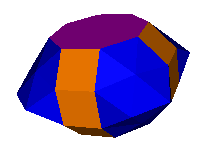
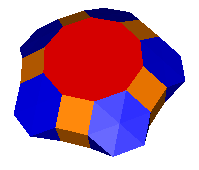
8-4-3-3 (left) and 10-4-3-3 (right)
n-4-3-3 polyhedra


8-4-3-3 (left) and
10-4-3-3
(right)
The solutions to the 8-4-3-3
and 10-4-3-3 acrons are obviously
related.
They are members of a family of polyhedra formed by wrapping a complex
of squares and triangles between two polygons. The squares
are in strips of three, the triangles are in complexes of fourteen.
In addition to the
above
linked octagonal and decagonal models, examples can be formed for other
n-gons, where n is even. The figures continue
above
n=12,but
as
there
is
now
an
angular
excess
the
triangular
complexes
become
folded.
n-4-3-3 with n odd
'7'-4-3-3
Due to the alternating nature
of the connecting squares and triangles, examples cannot be formed
where
n is odd. However a closely related toroidal family can be
generated
by utilising the degenerate 2n/2-gons (such as the 14/2-gon).
Examples
generated using these polygons can then have the base polygons removed
leaving the edges of the square and triangular rings
connected.
The resulting toroid has an n-gonal prismatic symmetry. A number
of examples are included in the zip files below.
Again, models can be generated for n/d where d>1:
Again a number of examples are included in the zip files below.
Isomerism
There are
a number of distinct isomers for each n - although some appear to have
limits as shown below. The names are
informal and are intended solely as an aid to recognition. It is not known if
the list below is complete.
The
zip files linked below each model contain WRL, OFF and TXT files for
each
model in the range. Where they can be generated, models are
included for n = 5/2, 3,
7/2,
4,
9/2,
5,
11/2,
6,
7,
8,
9,
10,
11,
12,
14,
16.
The links
in the above list are zip files of each isomer for that value of
n. A large zip file containing both sets of zip files is here.
Note that
in the isomer specific zip files below the star polygons have been
renamed, for example, 5/2 is renamed 2d5 (2 decimal 5). This is
so the models are presented in strict sequence of increasing X.
|
6-433_exo WRL
OFF |
6-433_endo WRL
OFF |
n-433_inverted_exo.zip (n = 5/2 - 16) |
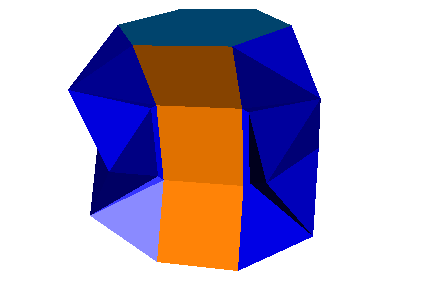 6-433 endo crossed WRL OFF n-433_endo_crossed.zip (n = 4 - 16) |
|
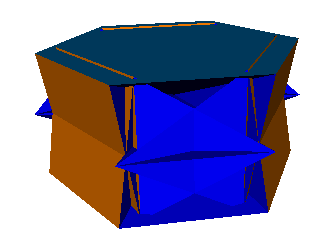 6-433 folded WRL OFF n-433_folded.zip (n = 5/2 - 14) |
|
|
|
|
|
n-433_exo_folded.zip (n = 5/2 - 16) |
|
n-433_chiral.zip (n = 5/2 - 16) |
n-433_inverted_exo_chiral.zip (n = 5/2 - 16) |
n-433_chiral_folded.zip (n = 5/2 - 12) |
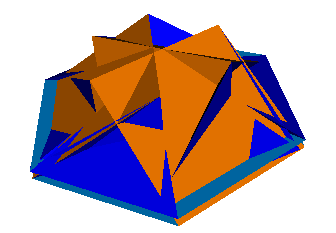 n-433_chiral_saucer.zip (n = 4 - 16) |
n-433_exo_chiral_folded.zip (n = 5/2 - 16) |
|
|
6-433 crowned hatbox WRL OFF |
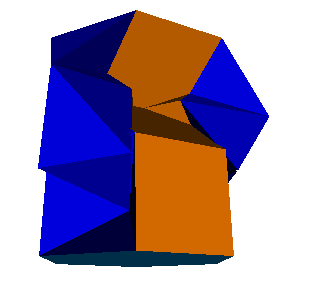 6-433 lighthouse WRL OFF n-433_lighthouse.zip (n = 4 - 16) |
|
n-433_crown.zip (n = 9/2 - 16) 4 is degenerate |
n-433_crown2.zip (n = 9/2 - 12) |
|
|
n-433_hatbox.zip (n = 5/2 - 16) |
|
|
|
|
|
|
The everted form is
remarkably
similar to 'cup' but they are two distinct forms. |
|
|
|
|
n-3-3-3-3 acrohedra.
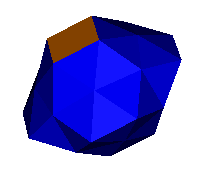
4-3-3-3-3
| WRL |
OFF |
|
| exo |
3 4 5 6 7 | 3 4 5 6 7 |
| endo |
8 9 10 11 12 14
15 16 17 18 |
8 9 10 11 12 14 15 16 17 18 |